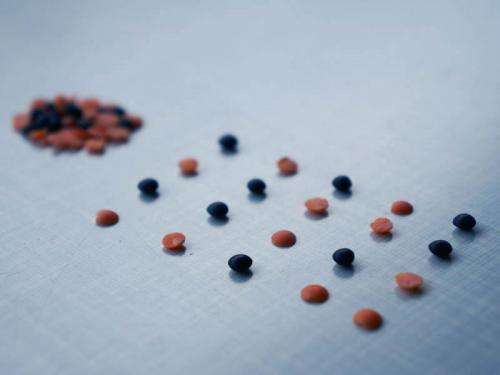Single cells: Same same but different

(Phys.org) —If half of a cell population were coloured white and the other half were coloured black, scientists should think all cells are grey. Conventional methods average over thousands of cells, overlooking any cell-to-cell variability. ETH scientists now measured metabolite levels in single yeast cells and unmasked the difference of one cell to the next.
Despite the fact that all cells in our body share the same genetic material, our skin cells look dramatically different for instance from muscle cells. However, even one skin cell may look different from the next, due to cell age, position in the cell cycle or environmental factors. Studying such subtle differences is important when it comes to determining the dose or duration of a drug treating cancer or infections. A cancer cell that is for any reason slightly different from the rest of the bunch may survive chemotherapy and induce the generation of a new tumour.
Usually, biochemists use large numbers of cells to measure robust signals for their studies. However, cell-to-cell variability is lost in the averaging: If half of a cell population displayed a high concentration of a certain factor which the other half lacked, the experiments would result in an average value and any existing distinct subpopulations would be overlooked. Renato Zenobi, ETH professor for Analytical Chemistry, and his colleagues developed a method to measure up to 160 single cells of the model organism baker's yeast.
Cells one by one
While methods targeting few or even single cells already exist, it has been unclear whether any of these methods is indeed capable of elucidating biological processes on the level of single cells. Alfredo Ibáñez and Stephan Fagerer, co-workers of Zenobi, were able to show that their method of cell singularisation and analysing metabolites with mass spectrometry can do exactly that.
In order to validate the method they treated the yeast cells with 2-deoxyglucose, which inhibits the degradation of sugar. At the same time they analysed a yeast strand with a mutation that has a similar effect as 2-deoxyglucose. Both, treated and mutated, were compared to untreated, not mutated cells. The effects of both, the treatment and the mutation are already known from previous studies with large numbers of cells. By comparison with these known values, the scientists were able to demonstrate that their single cell analysis indeed showed the same picture.
In addition, they were able to identify two subpopulations with a distinct difference: For one group – approximately 90 % – they found high levels of the metabolite fructose bisphosphate, whereas for the other 10 % those levels were rather low. These subpopulations had remained undetected by standard methods.
Avoiding technical artefacts
Prior to measuring single cells, the researchers treated the yeast cells with cold solvents to instantly freeze them and get an unaltered snap-shot of their natural state. This is crucial since the preparation of the cells for the experiment may introduce artefacts to the measurement. "The problem is quite similar to that encountered in quantum physics", explains Ibáñez. "As soon as we measure something, we change it". With Fagerer he has been working on optimizing the method to a point where such artefacts are minimal.
The ETH scientists rely on glass slides covered with a water-repellent material in order to isolate single cells. Using a laser they produced "holes" in this water-repellent coat and dragged a cell suspension across the surface. This way, micrometer-sized droplets remain in each "hole", containing one or few cells. Zenobi and co-workers hold a patent for this specially prepared glass slide and the method of singularizing cells.
Unmasking the differences
There has been increasing interest of scientists in analysing the many different individual states of single cells within a population. The new method allows for high-resolution snap-shots of these states and will contribute to elucidating biological processes.
"There are tons of books about raising a child", says Ibáñez. "But when my kid at home is crying in the middle of the night none of these books can help me to deal with this particular child in this particular situation." The same is true for biology: Many models exist for averaged populations. But how much individuals actually diverge from this mean is still largely unknown.
More information: Ibanez, A. et al. Mass spectrometry-based metabolomics of single yeast cells. PNAS 2013 May 28;110(22):8790-4. doi: 10.1073/pnas.1209302110.
Journal information: Proceedings of the National Academy of Sciences
Provided by ETH Zurich


















